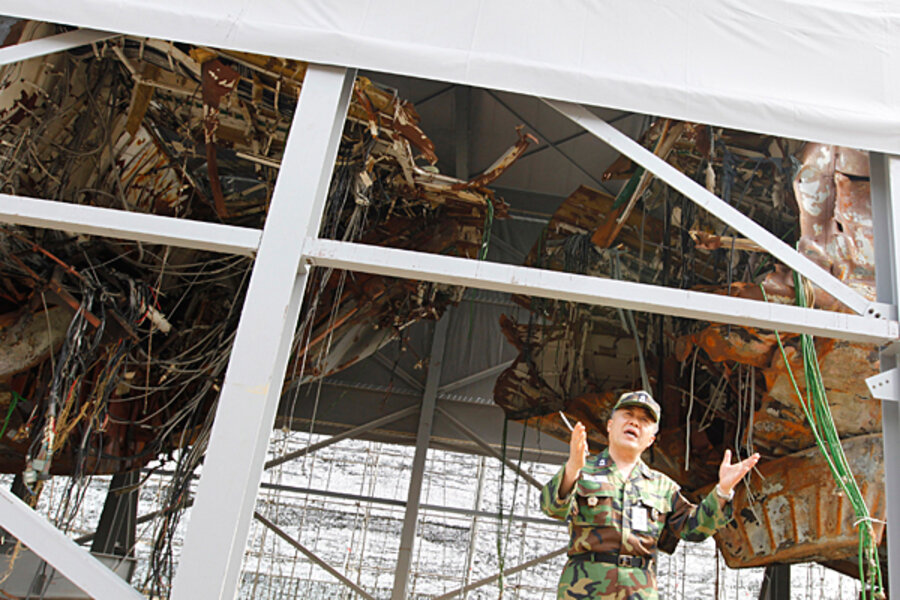Blaming North Korea, South offers detailed account of how torpedo sank Cheonan
Loading...
| Seoul, South Korea
The prolonged investigation into the sinking of the South Korean Navy corvette Cheonan does more than blame North Korea for the attack. It provides graphic details on the construction of a torpedo, how a torpedo works, and what happens when a torpedo is fired and hits its target.
In the campaign to generate international support for condemnation of North Korea, South Korea’s Defense Ministry meticulously summarized critical information in fairly simple language on the basis of conclusions reached by a Joint Civilian Military Investigation Group that included experts from 10 Korean agencies as well as the United States, Australia, Britain, and Sweden.
Here’s what happened after “a strong underwater explosion generated by the detonation of a homing torpedo below and to the left of the gas turbine room” of the Cheonan made it “split apart and sink,” according to the assessment of the Joint Civilian-Military Investigation group.
First, the “shockwave and bubble effect caused significant upward bending” of the keel of the vessel, “and the shell plate was steeply bent with some parts of the ship fragmented.”
Then, “on the main deck, fracture occurred around the large openings used for maintenance of equipment in the gas turbine room.” The bulkhead of the room “was significantly damaged and deformed.”
At the same time, “the bottoms of the stern and bow sections” were “bent upward” – further evidence of an underwater explosion.
Examined stern for six weeks
The investigation team, over the course of six weeks of examining the smaller stern section of the ship and the larger main portion, “found evidence of extreme pressure on the fin stabilizer,” needed to reduce rolling of the ship, as well as “water pressure and bubble effects on the bottom of the hull.” The fact that wires were cut “with no traces of heat” added to the impression of “a strong shockwave and bubble effect causing the splitting and the sinking of the ship.”
South Korean officials were convinced, after recovery of both portions of the ship, that North Korea was responsible, but the best evidence of a torpedo attack was discovery of the torpedo itself, including the motor with propellers and steering section, last Saturday.
The rusted torpedo, on display in a glass case at the Defense Ministry, was found after weeks of hunting by a commercial dredging ship at a depth of approximately 150 feet. The captain of the dredger said the nets for pulling it up broke a number of times, but “the moment it was above water, we thought instinctively, this is what we are looking for.”
Moreover, said a defense official, “the explosive substances found in the Cheonan and on the propeller were identical.”
The report offers still more precise information. The torpedo parts include “bladed contra-rotating propellers, propulsion motor and a steering section” that “perfectly match the schematics” of a torpedo “included in introductory brochures provided to foreign countries by North Korea for export purposes,” said the summary report.
The torpedo “utilizes acoustic/wake homing and passive acoustic tracking methods,” said the report. “It is a heavyweight torpedo with a diameter of 21 inches, a weight of 1.7 tons and a net explosive weight of up to 250 kilograms.”
It was the sheer force of the blast, not shrapnel or burning, that killed the sailors and broke up the ship, according to analysis attributed in the final report to the Korea Institute of Geoscience and Mineral Resources.
That analysis cited “seismic wave intensity of 1.5 degrees” and two infrasound waves with a 1.1 second interval, enough to tear apart the ship. “The seismic wave and infrasound waves originated from an identical site of explosion,” said the report. “This phenomenon corresponds to a shock wave and bubble effect generated by an underwater explosion.”
The investigators conducted “numerous simulations of an underwater explosion” that showed that a detonation with a net explosive weight between 200 and 300 kilograms had occurred at a depth of between approximately 18 and 27 feet, and nine feet left of the center of the ship’s gas turbine room.
The report categorically ruled out shifting tidal currents, metal fatigue, old mines in the area, collision with another vessel or an explosion inside the ship. These, it said, “played no part in the incident.”
Related:





